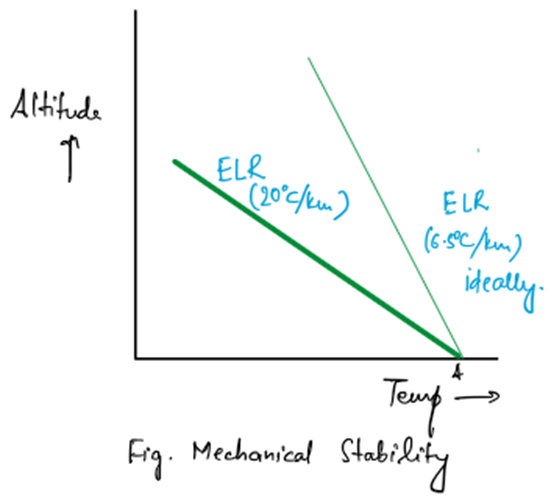Stability and Instability of Atmosphere: How Air Moves
Ever wondered why some air rises and forms clouds while other air stays still? It all depends on whether the atmosphere is stable or unstable.
What is Atmospheric Stability?
Atmospheric stability determines whether air will rise, sink, or stay still. This helps us understand cloud formation, storms, and air movements.
- Stable Air → Does not move up or down on its own.
- Unstable Air → Moves vertically due to temperature differences.
Vertical movement in air happens in two ways:
✅ Convectional upliftment → Air rises or sinks on its own due to temperature gradient.
✅ Forced mechanical upliftment → Air is pushed up by external factors like mountains (orographic uplift) or weather fronts.
What Controls Stability or Instability?
The behavior of rising air depends on three key rates:
1️⃣ Environmental Lapse Rate (ELR) → The actual rate at which temperature decreases with height (usually 6.5°C/km).
2️⃣ Dry Adiabatic Lapse Rate (DALR) → The rate at which unsaturated air cools when rising (10°C/km).
3️⃣ Moist Adiabatic Lapse Rate (SALR) → The rate at which saturated air cools after condensation (~5-6°C/km).
How Stability Works: The Three Conditions
1. Conditional Instability
💡 “Air rises when forced but later continues on its own.”
- When air is forced up, it cools at DALR (10°C/km).
- If ELR is less than DALR but more than SALR (DALR > ELR > SALR), air initially resists rising.
- Example: DALR: 10 oC/km; ELR: 6.5 oC/km; SALR: 5 oC/km
- At a certain height, the air reaches saturation and starts cooling at SALR (5°C/km).
- Now, the rising air becomes warmer than its surroundings and rises automatically.
✅ Example: In mountainous regions, air is forced to rise but later continues due to its own buoyancy.


2. Absolute Instability
💡 “Air rises freely without any external force.”
- If ELR is greater than DALR (ELR > DALR > SALR), rising air is always warmer than its surroundings and continues moving upward naturally.
- Example: ELR: 11 oC/km; DALR: 10 oC/km; SALR: 5 oC/km
- Once it reaches saturation, the air continues rising at SALR, since ELR is still greater.
✅ Result: Strong convection, leading to cumulonimbus clouds and thunderstorms.


3. Absolute Stability
💡 “Air resists rising and tends to sink.”
- If ELR is less than DALR and SALR (DALR > SALR > ELR), the rising air cools faster than its surroundings and becomes heavier.
- Example: DALR: 10 oC/km; SALR: 5 oC/km; ELR: 4.5 oC/km
- This air sinks back down, preventing vertical motion.
✅ Example: Inversions (cold air trapped below warm air) prevent cloud formation.


4. Special Case: Mechanical Stability
💡 “Unusual conditions where cold upper layers force air to descend.”
- If ELR is extremely high (15°C to 35°C/km), the upper atmosphere becomes very cold and dense.
- Heavy, cold air sinks, forcing warm air down.
✅ Example: Sudden cooling after volcanic eruptions or strong temperature inversions.


Final Takeaway: Why Does This Matter?
☀ Clear weather → Absolute stability prevents cloud formation.
🌧 Storms & Rainfall → Absolute instability leads to strong upward air currents and heavy clouds.
⛰ Mountain Weather → Conditional instability explains why mountains have more cloud cover.






